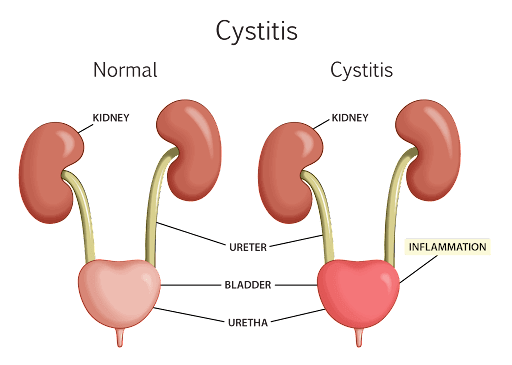Cystitis:
- Cystitis refers to the inflammation of urinary bladder
- It can occur is various species such as dog, cats, horses
- It occurs more frequently in females compared to males.
- Cystitis is manifested by frequent painful micturition and presence of cells of inflammation in urine.

Etiology:
- Infection: Bacterial infection are most common causes of cystitis. E. coli is main bacteria found in case of infection.
- Bladder obstruction by stones or calculi: The formation of urinary stones or crystals can irritate the bladder lining, leading to cystitis. This condition is more prevalent in certain breeds, like Dalmatians, due to their predisposition to forming urate stones.
- Trauma to bladder: It results from injury or faulty catheterization or Cystocentesis procedure.
- Tumor or blockage in urinary tract: Stones or tumors cause blockage in urinary tract resulting in cystitis.
- Chemical Irritants: Exposure to certain chemicals or toxins in the environment or through ingested substances can irritate the bladder lining.
- Exciting factors: Urolithiasis, difficult parturition, stagnation of urine, stricture of urethra. These factors interfere with process of urination and helps in bacterial invasion and multiplication.
Clinical Findings:
- Dull and depression
- Frequent urination (Pollakiuria)
- Pus in urine (pyuria)
- Hematuria (RBC in urine)
- Urine will turn turbid.
- Pain or discomfort during urination
- Increased thirst and water consumption
- Licking of genital areas excessively
- Palpation of bladder will reveal painful condition
- Rough and starring skin coat.
- In later stages, uremia may develop.
- Straddled gait
Diagnosis:
- Physical examination: Overall general examination of animal as well as palpation of abdomen and bladder helps in diagnosis
- Urinalysis: It helps to evaluate condition of urinary tract through urine sediment examination for presence of blood cells, crystals, casts, turbidity in urine
- Urine Culture and Sensitivity: If infection is suspected, a urine culture may be conducted to identify the specific bacteria causing the infection and determine the most effective antibiotics for treatment.
- Imaging: X-rays or ultrasound may be used to evaluate the bladder and urinary tract for stones, tumors, or other abnormalities.
- Cystoscopy: In some cases, cystoscope may be used to visually examine the inside of the bladder for abnormalities.
Treatment:
- Antibiotics are prescribed based on urine culture report, in case of bacterial infection.
- Pain relief medication; NSAID or opoids are administered to alleviate pain or discomfort in animals
- Special prescription diets may be recommended to dissolve urinary stones or prevent their formation.
- Urinary acidifier or alkalizer may be used based on pH of urine. Urine are made acidic by using sodium acid phosphate @ 40mg/kg, b.wt. and alkaline by using sodium bicarbonate @ 50mg/kg, b.wt.
- Intravenous or subcutaneous fluids may be administered to keep the pet hydrated and flush out the urinary tract.
- Manual emptying of bladder through pressure on bladder or through catheterization, if animal becomes unable to urinate normally
- In case of bladder tumors, surgical correction is required or chemotherapy is required. Radiation therapy may also be recommended.
- Irrigation of bladder with 1:1000 glycerine-acriflavin or glycerin-proflavin.